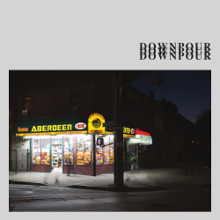The Graham Album Review #1981

Click on CD Cover for Audio Review in streaming mp3 format | |
Aberdeen: Downpour
by George Graham
(Independent release as broadcast on WVIA-FM 4/24/2019)

Click on CD Cover for Audio Review in streaming mp3 format | |
Aberdeen: Downpour
by George Graham
(Independent release as broadcast on WVIA-FM 4/24/2019)
The intersection of rock and jazz has taken numerous forms over the years. Back in the 1960s, groups like Blood Sweat and Tears and Chicago added jazzy horns to what were essentially rock songs. In the 1970s, the jazz-rock fusion scene arose, mainly in the wake of Miles Davis’ experimentation with electric instrumentation on his Bitches Brew album, and that gave rise to the fusion scene which itself branches into different stylistic paths, and persists to this day. So the jazz- rock scene featured vocals with the horns, and the fusion scene was almost always instrumental and more electric. This week, we have an album with a combination that I have not heard much before through the decades of jazz and rock intertwining. It’s a jazz-rock album with horns that is all instrumental. It’s by a Brooklyn-based large ensemble called Aberdeen. Their debut release is called Downpour.
In recent years there have been some interesting rock-oriented instrumental albums, including from William Tyler and Clothesline Revival. Snarky Puppy occasionally does a kind of rock-oriented blend with horns, but they are more jazzy in their musical complexion and in terms of the style of the compositions. Aberdeen don’t pretend to be a jazz group, though they could be a big-band with their 5 and 6 piece horn section, but their compositions are decidedly rock-based in their harmonic and melodic structure. In fact, in a video the band posted, there is an interview in which they deny being jazz but are a horn band that plays party music.
The group is headed by chief composer Brian Plautz, who plays alto sax in the ensemble. Another prominent figure in Aberdeen is guitarist Shubh Saran, whose own distinctive fusion album we featured in 2017 on this review series. The instrumentation is basically a rock band with usually two guitars, bass, drums, plus four or five horns, trumpet, two saxes, occasional trombone, plus percussion. In addition, most of the tracks feature a string trio, with two violins and cello. The result is music that is both familiar in terms of being fairly simple and rock-oriented but with big arrangements that impart an intriguing level of energy. The music also has a cinematic quality, that might evoke say a detective or spy movie. The emphasis is on more on the big sound textures and tight arrangements, with more limited opportunities for instrumental solos, another feature distinguishing it from big band jazz.
The liner notes attach significance to the inspiration for the compositions, with the material described as exploring the “search for identity.” With several of the titles stemming from a translation of the poems of turn-of-the-last-century Bohemian writer Rainer Maria Rilke.
Opening is a piece which epitomizes the distinctive sound of this album, It Was Here. The composition definitely sounds like the musical backing to a rock song minus vocalsm, but it stands well on its own, with the big horn sound. <<>>
Toward the Sky has a more cinematic quality with its shifts in dynamics and its vaguely unsettling melodic line. <<>>
That segues into a piece called Upholds It All, on which the strings are more prominent. <<>> The track is one of the few on which there is an extended solo, in this case by guest tenor saxophonist Bob Reynolds. <<>>
With guitars more prominent is Unspoken which builds to a nice crescendo. <<>>
The title piece Downpour is described in the liner notes as a “cathartic release,” and shows the interesting dichotomy of the big arrangement with what could be a kind of contemplative melodic line. <<>>
A track called BKNY, which presumably stands for Brooklyn, New York, effectively uses a long crescendo from the an atmospheric opening section <<>> to a big production sound with the strings and the electric band. <<>>
While the underlying compositions on this album tend to be fairly uncomplicated, the track called Clouds Form gets to sound more like an elaborate jazz or fusion piece. <<>>
The album closes with its most contemplative-sounding track, Still, which is probably the most melodic piece on this riff-oriented album. <<>>
Downpour the new debut album by the group Aberdeen, takes a distinctive approach to the intersection of jazz and rock, with instrumental performances featuring big horn arrangements of what are basically rock tunes. It’s all very well done, with the ensemble arrangements taking center sage, and not much in terms of instrumental solos or virtuosity. The tunes can make one think about what kind movie scenes might be good to go with the music, with its evocative quality.
Our grade for audio quality is an A-minus. The sound is generally clean, but sometimes the horns can get a little muddled-sounding. The recording’s dynamic range, while not at audiophile level, is better than most.
In listening to Aberdeen’s Downpour I am struck by how rare is this particular combination of familiar ingredients, jazz-rock with horns doing instrumental music. It’s also an album that can be considered interesting as foreground listening, as party music -- as one of the band members suggested -- or something to inspire your imagination to create images or scenes in your mind. In any case, it definitely makes for worthwhile listening.
(c) Copyright 2019 George D. Graham. All rights reserved.
This review may not be copied to another Web site without written permission.
 To Index of Album Reviews | To George Graham's Home Page. | What's New on This Site.
To Index of Album Reviews | To George Graham's Home Page. | What's New on This Site.